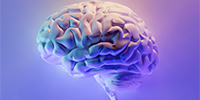The role of the brain extracellular matrix in brain clearance

The clearance of toxic macromolecules and metabolic byproducts from the interstitial/extracellular space (ECS) of brain parenchyma via interstitial fluid (ISF) is critical for the maintenance of brain homeostasis. Impairment of brain clearance leads to age-related brain deterioration and neurodegenerative diseases. Notably, the flow rate of brain ISF is dynamically regulated in the sleep/wake cycle, aging, and pathological conditions. However, the mechanism by which ISF flow is regulated is poorly understood.
ISF runs through the ECS, which is filled with extracellular matrix (ECM). We recently developed a novel tool, which specifically labels hyaluronan (HA)-based brain ECM. We attached a fluorescence acceptor tag (HaloTag) to a Link protein that specifically binds to HA chains (H-Link). H-Link reveals the organization of the brain ECM surrounding neurons (perineuronal net), astrocytes, and brain capillary in vivo and in vitro.
To study how brain ECM is regulated during sleep/wake cycle and how ISF flow affects the organization of the brain ECM, we propose a collaborative project combining this reporter assay, in vivo two-photon brain imaging, and a microfluid chamber system. We will determine whether artificial sleep regulates the volume and/or arrangement of the brain ECM in vivo and whether ISF affects the organization of the ECM of neurons and astrocytes in vitro.
The proposed experiment will for the first time reveal the dynamic changes in brain ECM.
Current Status
2021-09-15
Abstract:
The clearance of toxic macromolecules and metabolic byproducts from the interstitial/extracellular space (ECS) of brain parenchyma via interstitial fluid (ISF) is critical for the maintenance of brain homeostasis. Impairment of brain clearance leads to age-related brain deterioration and neurodegenerative diseases. Notably, the flow rate of brain ISF is dynamically regulated in the sleep/wake cycle, aging, and pathological conditions. For example, sleep increases the volume of the interstitial space and facilitates the flow of the ISF, which leads to the clearance of toxic amyloid-beta (A) and tau molecules from the brain parenchyma. However, the mechanism by which ISF flow is regulated is poorly understood. ISF flows through the ECS, which is filled with the brain extracellular matrix (ECM). Unlike peripheral ECMs that are mainly structured by collagens, the backbone of the brain ECM is composed of hyaluronan (HA), an unbranched carbohydrate chain, which provides structural flexibility of the brain ECM. Dynamic regulation of the structure and function of the brain ECM plays essential roles in the plasticity change during development, aging, and disease progression. Due to the lack of a contrasting reagent for HA-based ECM, however, the structure and function of the brain ECM are poorly understood. To monitor the dynamic regulation of the volume of the ECS and the structure of the brain ECM in vivo and in vitro, we have developed a novel tool, which specifically labels HA-based ECM. We attached a fluorescence acceptor tag (HaloTag) to a Link protein (HAPLN1) that specifically binds to HA chains (we named the reporter H-Link). Transduction of AAV:H-Link into primary neuronal cultures, primary astrocyte cultures, or the brain tissue followed by a brief application of a fluorescent HaloTag ligand (HTL) reveals the previously unrecognized architectures of the brain ECM: the interstitial matrix around astrocytes, WFA lectin-negative perineuronal net surrounding interneurons, and structured interstitial matrix surrounding excitatory neurons. Moreover, H-Link allows for longitudinal live-cell imaging in vivo and in vitro. This novel imaging tool will allow us to characterize the dynamic changes in the structure and function of the brain ECM during sleep, development, aging, and tissue repair process in normal and disease conditions.
Collaborators
Sungjin Park
School of Medicine
Neurobiology & Anatomy
Project Owner
Jim Heys
School of Medicine
Neurobiology & Anatomy
Hanseup Kim
College of Engineering
Elect & Computer Engineering
Project Info
Funded Project Amount$30K
Keywords
brain clearance, toxic macromolecule, interstitial fluid, extracellular space, extracellular matrix, glymphatic system, perineuronal net
Project Status
Funded 2020
Poster
View poster (pdf)
